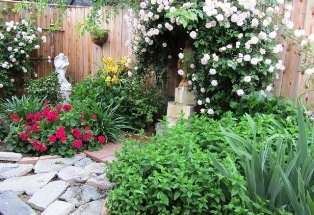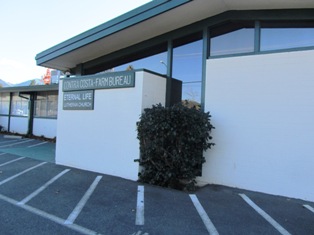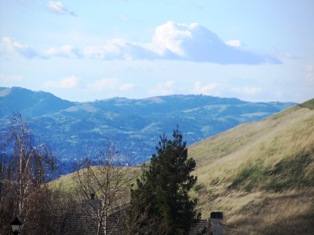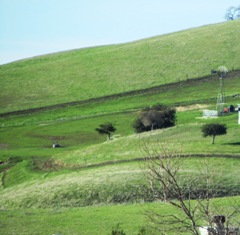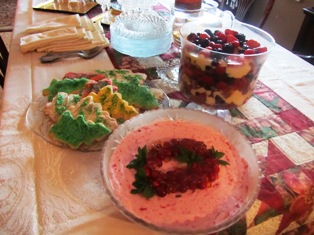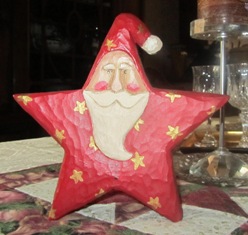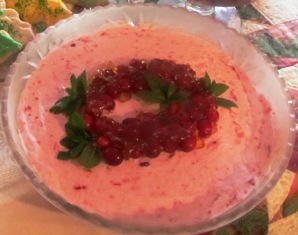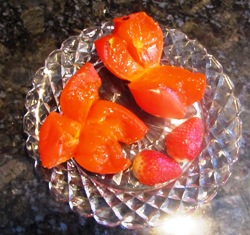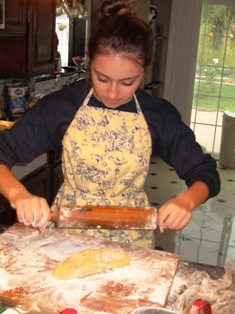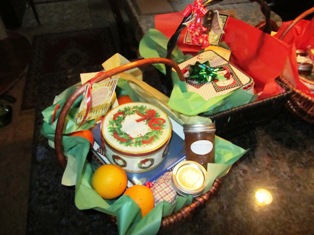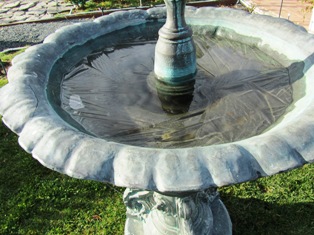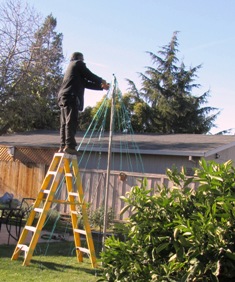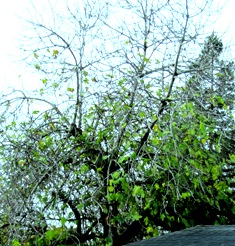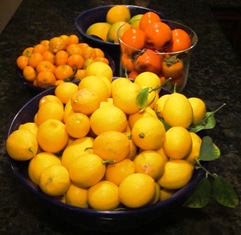Archive for December, 2012
Managing Rose Rust
I found rust on the undersides of leaves on some of my hybrid tea and floribunda roses while strolling around the farmette this morning. Usually by this time of year I have plucked off all the old leaves and cut the canes down to between 12 and 18 inches. The cutting back of hybrid teas and floribundas is necessary since those rose bushes produce flowers on new growth. Removing the leaves and cutting out the dead wood as well as pruning back the canes this time of year (end of December) encourages dormancy. I’m just now getting around to doing these chores.
Removing the foliage and destroying disease-infected leaves is a must. Do not put these in your compost pile. I keep a little bag next to me when I’m working with the roses in case I find evidence of rust or powdery mildew or black spot. Wind, rain, and overhead watering can spread the spores of these diseases. Destroying the leaves ensures that the plant gets a new start in the spring and that diseases cannot winter over on the foliage.
Rust most often appears on roses when the plant has moisture on its leaves for several hours. The rust infection looks like orange or yellow spots on the underside of the leaf. Eventually, it can migrate to the topside of the leaf as well. Leaves infected with rust will discolor and drop to the ground.
The long term solution to dealing with rust is to use drip irrigation or a soaker and to avoid overhead watering of your roses. As soon as you noticed rust, black spot, or mildew, remove and destroy any infected leaves and stems. Clean beneath the base of each plant and mulch with organic materials. That way, come spring your rose can start anew, producing strong canes, healthy leaves, and gorgeous blooms.
Plants for Sun Rooms, Solariums, and Conservatories
My husband and I grew exotic flowers in and around our Miami, Florida home. We had a sun room that sheltered a swimming pool in which I swam laps in every day. The space seemed near perfect for growing orchids in cycles of perpetual bloom. They loved loved the heat, light, and moisture provided by the pool and a fountain we installed. We also had an angel trumpet tree (Datura arborea) in the front of the house, adding drama and a luscious scent to the entry area.
But with the freezing winter temperatures on our Northern California farmette, such plants would not survive unless grown in a conservatory type of room with lots of warmth and light.
Since buying the farmette, my hubby and I have toyed with the idea of building such a space, also known as sun room, greenhouse room, tea room, and solarium.
A major consideration besides money and materials would be the direction the room would face. For our farmhouse, the direction (also known as “aspect”) could be north where the patio is already located or if positioned at the front of the house (where we had planned to create a wraparound front porch), the sun room or conservatory’s aspect would face south.
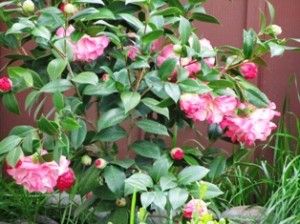
This Camellia japonica produces attractive blooms in early to mid spring and would do well in a cooler sun room
A north-facing aspect permits plenty of light but less heat. In a cooler conservatory or sun room, we’d use more foliage plants such as camellia, begonia, geranium, anthurium, Australian bottle brush, fuchsia, ficus, gardenia, campanula, hypoestes , and various types of ivy and palm. We could also grow Cymbidium orchids that like dappled shade during summer but bloom in the dead of winter.
A south or west direction ensures intense light and heat and would allow us to grow more flowering plants (especially ones found in the subtropics and tropics), including exotic orchids.
My husband grew up on a Caribbean island and loves orchids. The cymbidium orchids do well enough already outside. We put them in protected areas on frosty nights. But many of the exotic orchids require light, heat, and, in some cases, additional moisture.
We know Phalaenopsis, odontoglossum, and slipper orchids would thrive in a conservatory room that faces south or west as would many other plants such as hibiscus, jasmine, nephrolepsis, passion flower, plumeria, and African violet, to name a few. Also, many hybrid rhododendrons that profusely flower for long periods can be grown in containers in a warm environment.
I’m really an outside garden girl, but a conservatory room with a lot of interesting architectural detail and gorgeous blooming plants could make me want to spend more time indoors. It doesn’t matter to me whether it faces north or south. But dare I bring up the idea of adding a pool?
Gardens as Sacred Space

Painted with the French words for peace, love, and prayer, the blue trellis serves as a garden focal point
In seed time learn, in harvest teach, in winter enjoy.–William Blake
It feels like winter. No sun after a clear, cold night. The temperature at Lake Tahoe this morning was a level zero. Here on the farmette, the temperature is having trouble pushing out of the 40s. Though bleak outside, there is light and warmth in our little farmhouse. Soup gurgles in the pot on the back burner, and the seed catalogs are close at hand.
Remembering visionary poet William Blake’s admonishment to enjoy winter, I’m trying. The seed catalogs remind me of plants and gardens of my past, the great gardens of the world, and the secret places that all gardens hold–places awaiting discovery or re-discovery. Places that create magic in a garden.
My garden isn’t just a place to cultivate plants; it exists as sacred space, a tranquil retreat. There under trees and amid the roses that I invariably plant, my restless spirit knows its place and can find its peace.
Gardens are so much more than trees and flowers, chimes, statuary, benches, and fountains of flowing water. Far more important than what is visible in a garden is what is not seen . . . but felt.
A garden is a place of presence. One of my favorite writers John O’donohue, Anam Cara and Eternal Echoes) observed, “that presence is alive.” Sacred space beckons us to step away from the cacophony of the world and enter Kairos or God’s time to dream, create, pray, love, nuture Self, and experience the wild presences of Nature.
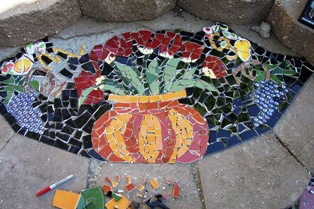
The best gardens always have a little surprise; this is a garden step I created some years ago while writing my Adventures in Mosaic book
We step in and out of the garden, a living and ever-changing landscape, but it is only when we linger in the landscape that we are embraced by the unseen–what O’Donohue referred to as silent and indirect presences.
A garden nourishes and nurtures. It was to the garden I turned after losing five family members in five years; my mother and my 46-year-old husband were the last to go. I hid myself away in our garden, turned on the water, and allowed my own tears to flow until none were left.
Later, I spent hours in the garden, mourning my loss, remembering my dreams, re-imaging my future, and praying for my aching heart to heal. Relief came as I created pique assiette mosaics and photographed them for a book to be published.
From broken china pieces and colored glass, I created a child’s tea table. When a local teacher told me about a girl in her class whose father needed a heart transplant and had no money for Christmas presents, I gave the table to his little girl.
In my garden, I found healing and wholeness and strength to again step into life. The power of sacred space can do that. It can uplift your spirit and nourish you with light and warmth when all seems so terribly bleak. Best of all, garden memories are bearers of light and joy, nourishing your spirit even on the darkest, coldest days of winter.
Learning about the Local Farm Bureau
I have passed the one-story stucco building at 5554 Clayton Road (#1) a gazillion times on my way to the post office and didn’t know until recently that it housed the Contra Costa County Farm Bureau. So today I stopped in for a visit.
Our farmette lies within one mile or so of designated California agricultural land. That means there are a lot of ranches and family farms in the area. In fact, most days, we can see cattle grazing on the verdant hills and pasture lands that surround us. Where there are ranches, there is likely a farm bureau.
The Contra Costa County Farm Bureau is supported by members, many of whom are ranchers and farmers in the county. The bureau’s efforts focus on maintaining the county’s agricultural heritage, promoting responsible land use, preserving open space, promoting confidence in food safety, and also supporting “Buy Fresh, Buy Local.”
“Buy Fresh, Buy Local” means that money spent on locally produced products keeps the money circulating in our community. The farmer’s markets provide great exposure for local small businesses. Concord offers two locations for its farmer’s market. The main one is at Todos Santos Plaza, the downtown park around which our small city is built. Last year, Concord High became the secondary location.
The Contra Costa County Farm Bureau works with 52 other county farm bureaus to protect California’s agriculture interests, including informing farmers about farm issues before the California Legislature. It keeps members updated on the latest issues of concern through its Farm Bureau Times newsletter. The August 2012 issue contains a comprehensive listing of the county’s year-round certified farmer’s markets.
The California Farm Bureau Federation publishes AgAlert, the weekly newspaper for California Agriculture. The latest issue provides 28 pages of information spanning diverse topics, including legislation, crop infestation and treatment, organic farming, water issues, range land conservation,and almond exporting.
Our Contra Costa Farm Bureau maintains a program for educating students about keeping bee hives, growing vegetables from seeds, seeing farm animals up close, and learning about the history of livery stables and early farming in California. For more information, contact the Bureau at 925-672-5115. If you have a local small business involving agriculture, consider joining your local farm bureau.
Christmas on the Farmette
Christmas is one of my favorite holidays of the year. The season is richly imbued with traditions that span cultures across the world. Although family traditions were always important to me, after enduring two cross-country moves and spending two years cleaning and renovating this farmette, my thoughts tend to focus more on future farmette projects than on resurrecting family traditions.
Still . . . we spruced up our home for the holidays by putting out festive nutcrackers, candles, and a hand-carved Santa. When my children were small, we elaborately decorated the house. Our farmette cottage is only a quarter of the size of our previous home and as-yet unfinished, so a bough of greens with red pepper tree berries seemed enough.
On Christmas Eve night, we entertained my daughter’s family and their friends in a progressive party. My daughter had proposed the idea a month ago.
The progressive party had been a family tradition before my first husband passed away following a heart transplant. Now I had a new spouse, a new house, and a new life. My daughter felt it was time to resurrect the progressive party tradition.
This year, the party would travel to two houses in Clayton, with our house as the last stop in Concord. All the houses were less than five to eight minutes apart.
- Rum-flavored English trifle to be topped with whipped cream and nuts
Appetizers and and a glass of holiday cheer got things started. We played two games of bingo with the children. Bundled up against the cold, we traveled to the next house, my daughter’s home. There we dinned on a hearty meal of ribs (slow-cooked for six hours), mashed potatoes, and green beans. After the meal, we pulled numbers from a bag that corresponded to a wrapped gift (all the gifts were white elephant presents or under five dollars). Gifts could be “stolen” from someone else, but only when it was your turn to choose.
The next stop on our progressive party was the Henny Penny Farmette for desserts. I had covered the table with a white silk tablecloth that I had purchased in Greece while writing my book, the Everything Women of the Bible. I picked blooms of purple iris and the last roses on the Sally Holmes bush and put them into a crystal vase for color. I placed crystal stemware upon gold trays, arranged forks in stacks alongside linen napkins. Finally, I put out some antique dishes to hold decorated cookies, a caramel cake, and candies.
It wouldn’t be Christmas at my house without the frozen cranberry souffle that I learned to make many years ago. Also I made an English trifle using blackberries, raspberries, blueberries, and strawberries. These fruits are layered with pound cake and egg custard. Just before serving, I add dollops of freshly made whipping cream and sliced toasted almonds. The desserts were paired with a choice of coffee, chilled apple-pear cider, or tea. I also put out a bowl of ripe persimmons.
After saying goodnight to everyone and sitting alone for a bit after Carlos went to bed, I found myself wishing we had included a gas fireplace in our remodel. Maybe next year. I wanted to kindle the ancient light of fire, sit mesmerized by its dance, and invite into my consciousness the numinous presence of the divine. As the Irish Catholic scholar John O’Donohue wrote, “something begins to change when we can see exactly where the walls of limitation stand in our lives.”
Maybe I don’t really need a fireplace, I think as I gaze at the candles burning. During my reverie, my thoughts turned to the divine in appreciation for such abundant blessings. Our life here isn’t easy, but what life we are living!
Sugar Cookies for Santa and the Elves
Everyone needs a little help during the holidays. An elf or two can make all the difference when you are trying to decorate the tree, hang stockings, and make all those special treats for Santa. I am baking dozens of batches of cookies to put into decorative tins that will then be tucked into baskets of other edible and gift items.
My book, Why Santa Wears Red, http://tinyurl.com/chp9sua (Fall River Press 2009), includes suggestions for things you can find in your back yard to decorate the house. In that book, I also include recipes for traditional fruitcake, cranberry scones, and fragrant herbal tea. But sugar cookies and pumpkin spiced cupcakes are two of my favorite holiday snacks.
Sometime during the summer, I purchased Nick Malgieri’s book, Cookies Unlimited and found a terrific sugar cookie recipe in it that I am using this year. It makes five dozen cookies per batch.
The ingredients are basic items (flour, sugar, and butter, for example) that you will probably have on hand if you like baking cookies. The texture is lovely and the cookies come out great every time. We iced them with a butter cream frosting and decorated with sprinkles before the icing could harden.
I enlisted help with the baking this year from family members. They also did the decorating and I packaged everything into the gift baskets. Each basket contains a few different items, depending on the family to receive them. In some, I tucked in one or two of my books, packets of seeds from my plants (like sunflowers, nasturtiums, zinnias, and marigolds), jars of apricot, white peach, or strawberry jam, and honey.
You might also add candy canes, tins of fudge, cookie cutters, scone mix, measuring spoons, fresh fruit, bags of nuts, and myriad other treats or kitchen utensils. Friends say they love getting these baskets. I think they are well worth the effort, especially when family members become helper elves in your kitchen.
Preparations for a Homemade Holiday
When you are renovating a house, you don’t welcome freezing weather. When I heard frost warnings for the overnight hours, I turned off my outdoor fountain. At the stroke of 7:00 a.m., I slipped into my knee-high rubber boots and trotted outside. There I found the water in the fountain frozen in a fractured geometric pattern, due most likely to the wind blowing across the water as it was freezing. If it’s going to freeze in Northern California, I guess this is the right time of year for it to happen.
My husband and I have been laboring away for over two years on this little half acre farmette and cottage and are a long way from being finished. With just the two of us doing all the work, it could take years–a sobering thought. Already the close of 2012 approaches. Christmas is five days away.
Driving to the local do-it-yourself (DIY) store in our little red truck to buy materials and tools, we are visually reminded of the time of year and the season, too, with outdoor decorations, lights, and Christmas trees covered in ornaments displayed in living room windows for miles.
I refuse to buy a cut tree. First of all, I’d really rather have a living tree in a pot or rosemary or some other herb sheared into a cone than to support the cutting and harvesting of a living tree such as the pine and spruce, so beloved as Christmas trees.
Sorry, it this offends, but my philosophy is that the trees we have on Earth are our planet’s lungs. Trees take carbon dioxide out of the air. They store carbon in their wood. They give off life-giving oxygen that each human needs.
But beyond my philosophizing, I look around my tiny, unfinished house and see no good place to park a tree of any type. So my husband, ever the architect, dreams up a plan to build a holiday tree on the back lawn and cover it with energy-efficient led lights.
He hammered a tall pole into the ground and then stretched wire from the pole top to 16 ground stakes. Using a board to draw a perfect circle around the base of the tree, he drove the stakes along the circle line. Each of the metal stakes had a slot or hole at the top through which the wire could be slipped through and tied off. From top to bottom, he strung the lights.
We can see our holiday tree through the glass patio door. Our little farmhouse now feels a little more festive, even without interior decorations. It also smells good inside with all the baking I’ve been doing. This year, we’re putting together baskets for gift giving.
We’ll fill the egg gathering baskets with jars of my summer stone-fruit jams, homemade cookies, loaves of pumpkin spiced bread and banana nut bread, fresh oranges and tangerines from our trees, and mini jars of honey tied up with gingham fabric and ribbon. Our baskets of homemade items find resonance with the way farmers of my grandmother’s era gave gifts. Somehow, the holiday seemed less commercial back then. So from our hearts to yours, we wish you have a lovely holiday season and a fantastic year ahead. As for us, the renovation goes on.
Herbs for Healing and Well-Being
For thousands of years, humankind has relied on the healing properties of herbs, plucked in the wild or cultivated in gardens, to treat what has ailed them. Modern holistic practitioners value herbs and plant-based medicines as integral elements in re-balancing the health of their patients and fostering wellness and robust vitality.
Doctors trained in allopathic or mainstream Western medicine traditionally have prescribed chemically based medicines (that usually have side effects). However, Western-trained doctors may also recommend the use of herbs for certain health issues. Always talk with your physician before starting any type of self-treatment with herbs. Keep your physician informed of herbs you may be taking. Herbs or herb formulations can interact or even block the efficacious effect of the medications your doctor has prescribed.
Dr. Andrew Weil, the Harvard-trained physician who pioneered the field of integrative medicine (combining mainstream and alternative medicine) and also wrote several best-selling books, suggests three specific herbs can reduce inflammation in the body–tumeric, ginger, and boswellia. These herbs can be found in specific doses formulated in capsules to make it easy to take the right amount. See, http://www.drweil.com/drw/u/QAA142972/Anti-Inflammatory-Herbs.com.
In traditional Chinese medicine, four herbs play vital roles in achieving a state of well-being. Rosemary stimulates brain alertness, mint aids in digestion, sage supports mental acuity, and parsley protects the eyes. See, http://www.doctoroz.com/blog/mao-shing-ni-lac-dom-phd/4-commonly-used-healing-herbs.
Whether herbs are used dried or fresh, made into a tea, tincture, culinary preparation, or packaged in capsules and other forms, they are often included as part of a larger health-focused program to restore and maintain a balanced, healthy body.
Ayurveda, a healing system used in India since ancient times, utilizes herbs in treatments that can encompass many healing modalities. According to Ayurveda, a balanced, healthy body depends on a strong metabolic and immune system, attained through proper nutrition, exercise, yoga, and meditation (to relieve tension and stress that can accumulate in the body and mind).
Herbs used in Ayurveda are many and include (but are not limited to) andrographis, ashwagandha, black mustard seed, cardamom, coriander, cumin, ginger, purslane (pigweed), tulsi (holy basil), tumeric, and visnaga.
During the medieval period, gardens of priests, convents, and cloisters contained the herbs that members of the clergy as well as ordinary people believed could treat or cure them of their ailments. In the twelfth century, German mystic Saint Hildegard of Bingen wrote about health and healing, detailing medicinal uses of over 200 healing plants.
Although most herbs are fairly easy to grow, take the time to learn about them. Provide for the plant’s needs (water, nutrients, sun or shade requirement). Find out when to harvest and how best to use the plant for your health and well-being. Find out what the negative factors might be in using a specific herb or medicinal plant. When you engage in this type of work, you continue a practice begun thousands of years ago that can have health benefits for you today. But don’t forget to have that discussion with your doctor before taking medicinal herbs.
Winter, Time of Dormancy for Figs and Other Fruit Trees
Only four days remain until the official onset of winter. Drifting leaves from the Mission fig tree towering above my neighbor’s rooftop catches my attention. The fig’s thick trunk and spreading branches form a scaffold that sways against the western sky, pushed by a storm wind advancing from off the Pacific. It took most of autumn for the grand old fig to shed its canopy. Now most of its leaves lie on the ground like pieces of a discarded garment in Mother Nature’s closet.
Human hands, raccoon paws, and squirrel feet removed the tree’s fruit over the summer and fall. The fig remains picturesque with its lowest branches as thick as its trunk and with some trunks gnarled and covered with green moss.
The grand old fig stands stark and vulnerable, soon to rest in complete dormancy, in contrast to its unabashed fecundity during summer. The tree must await spring’s light and warmth to reawaken. For now, the fig’s heavy, gray bark finds resonance in weathered buildings, barns, and fences built more than a half century ago in this part of Contra Costa County.
During spring and summer, when its sap is rejuvenated and flowing with life-giving nutrients, the fig sprouts a lush canopy of bright green leaves. Later, it prolifically produces sweet fruit that grow as large as a man’s fist.
Mother Nature isn’t as precise as the dates on our calendars.Her seasons ease seamlessly from one into another. Colder and darker days of winter are yet to come. For many plants, the season of cold and storms is a time of rest; a dormant period from which they will emerge anew. The fig will again blossom, leaf-out, produce fruit in a new cycle. This is the promise of spring, the hope of gardeners. Until then, the tree has earned a much-needed rest.
Winter Bounty of Fruit is “Preventative Medicine in Bowls”
The overnight temperature is expected to drop to freezing. The cold front moving through prompted my lovely neighbor Wajiha to offer me the gift of lemons and persimmons from her trees before the freeze hits. I had already been pulling off the ripe Satsuma mandarins and oranges from my own trees.
My husband and I will squeeze the juice from the lemons and freeze it with a little water, our version of frozen concentrate, to make lemonade. The need to remove the ripe fruit caught me by surprise or I would have had my marmalade recipe, preserve jars, and my canning equipment ready to make some marmalade or conserve.
Jam-making will have to wait as I’ve already made arrangements for cookie making and other holiday baking over this weekend. The Hachiya persimmons have turned a lovely orange color but are not yet soft. That means they’re still too astringent to eat.
As soon as the persimmons reach the jelly-soft state, I will be able to eat them or use them in pudding and baked goods. Persimmons are like an anti-aging fruit. They provide a rich source of powerful antioxidant compounds such as vitamins A and C, folic acid, beta-carotene, lycopene, and lutein. These compounds protect against free radicals that damage cells in the body.
The citrus fruits are a great source of vitamin C and help strengthen the immune system. So I’m looking at all this citrus in my kitchen and thinking how lucky I am to have all this “preventative medicine in bowls.”
 Facebook
Facebook Goodreads
Goodreads LinkedIn
LinkedIn Meera Lester
Meera Lester Twitter
Twitter





